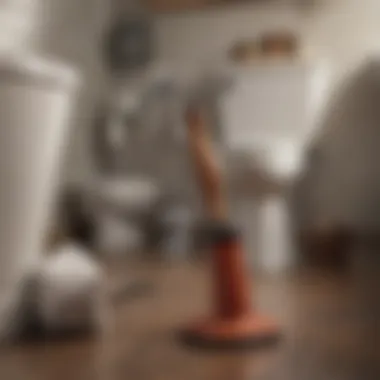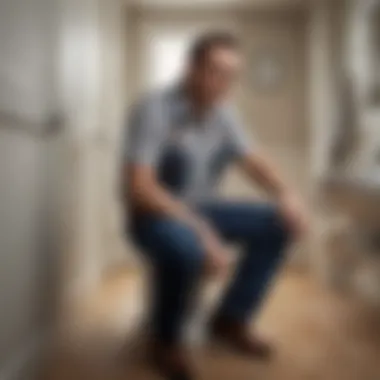How to Resolve a Clogged Toilet Overflowing with Water


Intro
A clogged toilet filled with water presents a challenging situation for any homeowner. Understanding the causes and implications can significantly ease this problem. Often, clogs arise from excessive toilet paper, foreign objects, or even pipe issues. When water remains in the bowl, it can lead to stress, potential overflow, and sanitation concerns. This article aims to equip readers with practical strategies for effective resolution while exploring preventive measures to avoid recurrence.
Recognizing when to tackle the issue independently or call a plumber can also make a world of difference.
Understanding the Causes of Clogs
Clogs in a toilet are common, but knowing the root causes can be enlightening. A typical reason is the misuse of toilet paper. People may flush more than recommended, causing blocks. Moreover, items like wipes, sanitary products, or toys can inadvertently find their way into the toilet bowl.
Additionally, plumbing issues can contribute to clogs. A slow drainage system or improperly installed pipes may exacerbate the situation. Regularly inspecting toilet functionality can pay dividends in long-term maintenance.
Implications of Standing Water
Water sitting in a clogged toilet can pose several issues. First, there’s the health risk. Standing water can become a breeding ground for bacteria and odors. Furthermore, there’s the risk of overflow if too much water builds up, leading to more extensive home damage.
"Addressing a clogged toilet promptly is essential to prevent lasting damage and ensure a healthy home environment."
Practical Strategies for Resolution
When faced with this issue, several strategies may be employed. The first step is to remain calm. Panic can lead to rushed and ineffective actions. If it’s safe, turn off the water supply to prevent further water accumulation.
Here are steps for resolution:
- Use a Plunger: A traditional plunger can be effective. Ensure the plunger creates a seal around the drain. Pump it a few times to attempt to dislodge the clog.
- Try a Toilet Auger: If plunging doesn't work, using a toilet auger can be a good next step. This tool can reach further into the plumbing.
- Hot Water: Pouring hot (not boiling) water into the bowl can help break down obstructions. It can soften the materials causing the clog.
What to Avoid
While it may be tempting to resolve clogs using chemical drain cleaners, avoid these products. They can damage pipes and create more serious plumbing issues. Focus on mechanical solutions first.
Preventive Measures
Keeping toilets functioning properly is all about prevention. Educate family members on proper flushing habits. Create a clear distinction for waste removal; only toilet paper should go down the drain.
Additionally, schedule regular plumbing maintenance to catch issues before they escalate. Self-inspections, such as checking for leaks or slow draining, can be very beneficial.
When to Call a Professional
Sometimes, despite the best efforts, the clog remains persistent. If you’ve tried plunging and augering with no success, it may be time to consult a professional. Look for a licensed plumber with good recommendations to correctly diagnose the problem.
Foreword to Clogged Toilets
Clogged toilets represent a commonplace issue in many households, yet they can pose significant inconveniences. Understanding how to navigate these situations enhances a homeowner’s ability to maintain a functional bathroom. This article focuses on the intricacies of a toilet clogged with water, including its causes, implications, and actionable strategies for resolving it.
Understanding the Problem
A clogged toilet filled with water is more than just an annoyance; it is an indication of a deeper issue within plumbing systems. Toilets experience clogs due to various reasons, such as excessive waste or foreign objects obstructing the drain. When confronting a toilet clogged with water, it is crucial to assess both the immediate symptoms and underlying causes. This understanding helps homeowners effectively address the problem rather than merely reacting.
Homeowners often underestimate the significance of recognizing the patterns and symptoms associated with toilet clogs. Gaining insight into the mechanics behind it will empower residents to respond confidently. Clogs may result from simple blockages or issues deeper in the system, which could necessitate different removal approaches. Thus, understanding the problem is the first step towards a long-term solution.


Impact on Homeowner Daily Life
The impact of a clogged toilet extends beyond mere irritation; it fundamentally disrupts daily routines. For a family or individual, loss of toilet functionality can lead to substantial inconveniences. It is essential to highlight how quickly this problem can escalate from a minor issue to a full-blown crisis.
The implications of a clogged toilet include:
- Loss of Sanitation: An inoperative toilet can compromise hygiene and sanitation, creating a health risk for the occupants.
- Increased Stress: The disruption of daily life can elevate stress levels, especially for families with children or for individuals who are busy.
- Potential Damage: Continuous overflow or standing water can lead to water damage, mold growth, and structural concerns within a home.
A homeowner must appreciate these challenges to promote prompt and effective action when encountering a clogged toilet. Ultimately, the knowledge gained from this section lays the groundwork for understanding how to manage this common household issue.
Common Causes of Toilet Clogs
Understanding the common causes of toilet clogs is essential for homeowners seeking to maintain a functional bathroom. Identifying these causes can save time, reduce frustration, and potentially save money on plumbing repairs. Clogs often arise from everyday habits and issues that can be quite easily avoided with proper awareness.
Excessive Toilet Paper Use
One of the primary reasons for toilet clogs is the excessive use of toilet paper. While toilet paper is designed to dissolve in water, using too much can overwhelm the system. This situation often occurs in households where multiple family members use the same toilet or when guests are visiting. To manage this, homeowners should set reasonable limits on the amount of toilet paper used per flush or consider eco-friendly options designed to dissolve more readily.
Foreign Objects in the Bowl
Foreign objects inadvertently dropped into the toilet bowl can also lead to significant clogs. Items like feminine hygiene products, toys, or even personal care products can create a blockage that standard flushing cannot handle. It is crucial to establish clear guidelines about what should and should not be flushed. Moreover, educating family members, especially children, about the risks associated with flushing inappropriate items can prevent these situations.
Pipe Issues and Restrictions
Sometimes, the problem lies within the plumbing system itself. Over time, pipes can accumulate debris or develop restrictions that impede the flow of water. Factors such as age, material, and previous repairs can all contribute to this issue. Homeowners should be aware of the state of their plumbing system and consider regular inspections, especially in older homes where pipes may not be up to code.
Sewer Line Problems
Lastly, more severe issues can arise from problems within the sewer line. Blockages, tree root intrusions, or breaks in the sewer line can lead to frequent clogs. These situations can be challenging to diagnose without professional help. Therefore, being vigilant about any signs of sewage backup in the yard or unusual toilet behavior is key. If such signs present, it’s logical to consult a professional to investigate the situation thoroughly.
Understanding these common causes will better equip homeowners to deal with clogs when they occur, promoting a more comfortable and functional living environment.
Identifying a Clogged Toilet Filled with Water
When a toilet becomes clogged and filled with water, recognizing this situation promptly is essential. This understanding not only aids in determining the appropriate course of action but also minimizes potential damage to the plumbing system and surrounding areas. Early identification can reduce stress and enable homeowners to tackle the issue before it escalates.
Signs of a Clog
Several indicators suggest the presence of a clog in the toilet. Look for the following signs:
- Slow drainage: If the toilet takes an unusually long time to empty after a flush, it may be a sign of a blockage.
- Gurgling noises: Strange sounds coming from the toilet or nearby drains while flushing can indicate air trapped in the plumbing.
- Excess water level: A notably high water level in the bowl after attempting to flush- without normal drainage is a clear sign of a clog.
- Unpleasant odors: Strong odors can often arise from stagnant water in the bowl before overflow occurs.
Recognizing these signs early can prevent more severe clogging and possible overflow issues.
Assessing Water Levels
Once you've identified the signs, the next step is assessing the water levels in the toilet. It's crucial to have a clear understanding of the current situation.
- Observe the bowl: Check how high the water level sits in the bowl. If the water is near the rim, there is a heightened risk of an overflow.
- Track changes: Make a note of whether the water level changes after trying to flush. Consistent higher levels indicate a serious clog.
- Check for leaks: While observing water levels, look for any leaks or cracks in the toilet to prevent further complications.
"Understanding the water level allows you to gauge the urgency of the situation, guiding your next steps in resolution."


These assessments not only enable homeowners to act decisively but also assist plumbing professionals in diagnosing issues more efficiently if external help is needed.
Immediate Solutions for Clogs
Using a Plunger
A plunger is one of the most basic yet effective tools for tackling a clogged toilet. It works by creating pressure to help dislodge the clog. To use a plunger, first ensure you have a flange plunger, designed specifically for toilets. Here is how to use it:
- Preparation: If the water level is too high, it may spill onto the floor. Use a bucket to remove some water if necessary.
- Placement: Position the plunger over the drain opening, making sure it forms a seal.
- Action: Push down with force and then pull up sharply. Repeat this motion about 10-15 times.
- Check: After several attempts, flush the toilet to see if the clog has cleared.
A few points to note: If you feel resistance or the plunger seems ineffective, do not continue to use it. Excessive force can damage the toilet. The plunger is ideal for clogs caused by organic materials and toilet paper, as it directly targets the blockage.
Employing a Toilet Auger
If a plunger fails, a toilet auger serves as a reliable alternative. An auger is a more specialized tool that can reach deeper clogs in the bowl and drain. It consists of a long, flexible metal cable perfect for maneuvering through pipes. Here’s how to use it effectively:
- Insert: Insert the auger into the toilet bowl, pushing it down the drain until you encounter resistance.
- Crank: Turn the handle of the auger clockwise to break up or hook the clog.
- Withdraw: Once you believe the clog is cleared, slowly pull the auger back out while continuing to twist it. This ensures any debris is pulled with it.
- Flush: Flush the toilet several times to ensure everything is flowing freely.
Pro Tip: Be cautious when using the auger excessively, as it can scratch or damage the porcelain within the toilet. An auger is particularly effective for tough clogs caused by non-flushable items or a significant buildup in the plumbing.
Attempting a DIY Solution
If conventional methods have not produced results, a DIY approach can be considered. Many substances around your home can help to break down clogs. Here are a few common solutions:
- Baking Soda and Vinegar: Pour one cup of baking soda followed by one cup of vinegar into the toilet. Let it sit for 30 minutes, then flush. The chemical reaction can help shift minor clogs.
- Dish Soap: Pour about half a cup of dish soap into the toilet bowl. Wait 15 minutes to allow the soap to lubricate the clog, then attempt to flush or use a plunger.
- Hot Water: Heat a pot of water until just boiling. Carefully pour it into the toilet from waist height. The force and heat can help dissolve and push through minor blockages.
These DIY methods may work well for less severe clogs and can be a helpful first step.
Remember, quick action can often prevent a simple clog from escalating into a larger and more costly plumbing issue.
By utilizing these immediate solutions, you can regain functionality in your bathroom while averting more serious complications.
Managing Standing Water
Managing standing water in a clogged toilet is a critical aspect of dealing with such plumbing issues. It is essential to address standing water promptly to prevent further complications. Ideally, homeowners should approach this task with a clear understanding of the situation and its potential ramifications. The presence of standing water not only poses a hygienic risk but may also cause more extensive damage to the bathroom floor and structure over time.
Safety Precautions
Before attempting to manage standing water, it is crucial to take several safety precautions. The first step is to ensure that the toilet is no longer connected to the power source if it has any electrical components, like a heated seat or a light. Wear rubber gloves to protect your skin from any bacteria that may be present in the water. Additionally, consider wearing a mask to avoid inhaling any potentially harmful odors. It is advisable to keep the area well-ventilated to minimize any unpleasant smells and to ensure safety while working on this problem.
Here are some safety precautions to keep in mind:
- Wear protective gear: Use gloves and possibly masks to shield from germs.
- Turn off water supply: Prevent further flooding by stopping the water to the toilet.
- Ventilate the area: Open windows or doors to circulate air and minimize odor.
- Keep children and pets away: Ensure that the working area is secured to prevent accidents.
Removing Water Safely
Once safety measures are in place, initiating the removal of standing water can begin. The method for removing water depends on the volume and accessibility of the water involved. A common approach is to use a wet/dry vacuum. This tool is efficient for sucking up standing water without excessive manual labor.
If a vacuum is not available, a simple bucket can suffice. Manually scooping water out allows for control over the situation, though it may require more time and effort. Here’s a step-by-step process for removing water safely:
- Gather necessary tools: Collect a wet/dry vacuum or buckets, and towels for any residual water.
- Remove excess water: Use the vacuum or buckets to remove as much water as possible from the toilet bowl.
- Clean the area: Once the bulk of the water is removed, clean the surrounding area to eliminate any lingering bacteria or odors.
- Check for leaks: After removal, inspect the toilet and surrounding pipes for any signs of leaks that may need attention.


By taking a thoughtful approach to managing standing water, homeowners can mitigate damage and maintain hygiene while addressing the plumbing issue effectively. It is a vital part of the process that paves the way for resolving the underlying clog.
Preventing Future Clogs
Preventing future clogs is essential to maintaining a functional toilet. The advantages of adopting preventive measures are multi-faceted. Not only does it save you from dealing with the stress of a clogged toilet, but it also reduces the potential for water damage and associated repair costs. Additionally, understanding how to maintain a toilet can extend its lifespan, making it a more reliable fixture in your home.
Establishing Proper Usage Guidelines
Establishing proper usage guidelines is crucial for the prevention of toilet clogs. One of the most common mistakes homeowners make is flushing inappropriate items. It is advisable to use only toilet paper that breaks down easily in water. Avoid flushing paper towels, feminine hygiene products, or any foreign objects. By communicating these guidelines to all household members, you can significantly decrease the likelihood of a blockage.
Another practical guideline is to limit the quantity of toilet paper used per flush. This helps in minimizing the bulk that can contribute to clogging. Furthermore, educating children about what should and shouldn’t be flushed is equally important.
Regular Maintenance Tips
Regular maintenance is a key contributor to preventing future clogs. Simple steps can greatly enhance the functionality of your toilet. First, it is important to inspect the toilet tank regularly to ensure all components are working properly. A malfunctioning flush valve or fill valve can lead to issues in flushing efficiency.
Aside from inspection, consider adopting a routine of cleaning the toilet with a non-abrasive cleaner. This helps in eliminating buildup from hard water and mineral deposits, which can interfere with optimal operation. Similarly, using a toilet bowl cleaner or enzyme-based product periodically aids in breaking down any organic matter that may cause clogs.
In addition to these maintenance tasks, it's beneficial to conduct an annual plumbing inspection. Hiring a professional plumber to analyze the piping system can catch early signs of potential blockages, saving you from future headaches.
Culmination
Ultimately, preventing future clogs involves a combination of proper usage guidelines and consistent maintenance. By taking these proactive steps, you not only keep your toilet in good working order but also create a more pleasant bathroom experience.
When to Call a Professional
Signs Indicating Professional Help
Several indicators suggest that it is time to call a professional. If you notice persistent clogs that resist standard solutions like plungers or augers, it might signify a deeper issue within the plumbing system.
Other signs include:
- Repeated Clogs: If your toilet frequently becomes clogged after you have attempted to resolve the issue multiple times without success, it is likely a symptom of a larger problem.
- Water Backup: Backup in other fixtures or standing water in the bathtub or sink points to potential sewer line issues. This situation may indicate a blockage or a significant plumbing failure that needs a professional assessment.
- Foul Odors: An unpleasant smell can indicate that sewage or waste is not traveling correctly through your plumbing system. This can be harmful to your health and should be addressed immediately.
- Indications of Water Damage: Noticing wet patches, stains, or mold growth around the toilet or bathroom can imply leaks or further damage. Ignoring these signs can result in costly repairs.
- Inability to Flush: If the toilet will not flush even after using a plunger or auger, it is time to stop and seek help.
Recognizing these signs early can prevent larger problems from escalating and ensure your bathroom remains functional and safe.
Choosing the Right Plumber
Selecting a qualified plumber is essential for addressing your toilet issues effectively. It is important to do thorough research before making a decision. Here are several factors to consider:
- Check Credentials: Ensure the plumber is licensed and insured. This guarantees they meet local regulations and can provide compensation for damages or accidents during repairs.
- Experience and Specialization: Look for a plumber who specializes in toilet repairs and drainage issues. Their specific expertise can lead to quicker and more effective resolution of your problem.
- Read Reviews: Look online for reviews on platforms such as Reddit or Facebook. Feedback from previous clients can provide insights into their professionalism and job quality.
- Request Estimates: Get multiple quotes from different plumbers. This can help assess the average cost and avoid overpaying for services.
- Ask About Guarantees: A good plumber typically offers warranties on their work. This ensures that if issues arise post-repair, they will address them without additional cost.
By following these guidelines, you can make informed decisions when seeking professional plumbing help. This helps in maintaining a functional home and reducing stress during a plumbing crisis.
The End
Recap of Key Points
- Understanding the Problem: A clogged toilet can disrupt daily life, making it crucial to identify the issue early.
- Common Causes: Recognizing factors that contribute to clogs, such as excessive toilet paper use or foreign objects, can help in preventing future incidents.
- Immediate Solutions: Utilizing tools like a plunger or a toilet auger must be the first step in troubleshooting.
- Managing Standing Water: Safety precautions when dealing with water are essential to avoid hazards such as slips or bacterial exposure.
- Preventing Future Clogs: Establishing guidelines for proper usage and regular toilet maintenance can significantly reduce the likelihood of clogs.
- When to Call a Professional: Knowing when to seek professional help can save time, effort, and potential damage to plumbing.
By grasping these key points, homeowners can address a clogged toilet with confidence and competence.
Encouragement for Homeowners
Homeowners should feel empowered to take control of their bathroom maintenance. A clogged toilet need not be a source of stress. Proper techniques and preventative measures can lead to a more functional and less problematic bathroom environment. Familiarizing oneself with basic plumbing concepts and tools will also enhance the ability to handle future issues effectively.
Remember: Staying calm and informed is the best approach when dealing with household plumbing challenges. Regular check-ups and maintenance can go a long way in avoiding unexpected situations.















